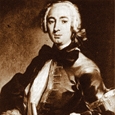Musicians today regularly face the question of how to creatively communicate with an audience, while still remaining true to performance practice and a composer’s vision. Although musicians operate as the conduit through which a composer’s vision comes to life, there is plenty of room for emotion and expressivity. There are many expressive devices that musicians use to enhance a performance including tone color, dynamics, vibrato, and rubato. Rubato is a particularly effective technique but is one that is not widely discussed or researched and therefore remains rather enigmatic to many musicians. In order to successfully incorporate rubato, it is necessary to understand the context of its use.
From the very beginning of music history to the present, performance practice allowed the use of freedom of tempo to enhance the expressivity of music. The Italian word rubato translates as robbed or stolen. It refers to a freedom of rhythm or tempo taken by a performer in order to enhance expression. In modern performances originality is encouraged and highly valued, and this technique can add an extra edge of ingenuity to a performance.
Rubato exists in two forms, labeled earlier and later. Earlier rubato first occurred in the fourteenth century, but became obsolete in the nineteenth century. It involves rhythmic freedom in the melody, while the accompaniment maintains strict time. Baroque ornamentation is the most well-known type of earlier rubato.
Later rubato is what most musicians associate with the word rubato, however. Although evidence of later rubato can be traced back to the beginning of music history with the performance of Gregorian chant, it came to be the predominate type in the second half of the nineteenth century with the advent of Romanticism. It includes the rhythmic flexibility of an entire musical body, used to highlight particularly heightened moments in music.
Gregorian Chant
Evidence of rubato can be traced all the way back to the beginning of music history. Flexibility in tempo took place even before tempo markings and the standard Western notation system were developed. Although the word rubato was not yet associated with the technique, freedom in tempo occurred as part of the performance practice of many early genres of music. Gregorian chant, the ancestor of Western plainchant, formed the basis of the majority of music existing from the ninth to sixteenth centuries. The main purpose of Gregorian chant was to communicate the meaning of the text. The monophonic melodies of Gregorian chant consist of notes that form shapes called neumes and are most often found in the shape of a square. Due to an absence of what modern musicians would consider a basic unit of pulse and meter, Gregorian chant has a sense of rhythmic freedom. Rhythm is derived from the flow of the melody and the syllables in the text, rather than a pre-fixed metrical unit of time. In order to add to the sense of flow in the music, performance practice permitted the lengthening or shortening of syllables in order to call attention to particular moments in the text that serve to enrich the main message.
Manuscripts from about the ninth to eleventh centuries contain symbols or letters attached to the neumes that convey tempo modifications to enhance the meaning of the text. For example, the letter c refers to the Latin word cito, or celeriter, which translates as quickly. The letter t refers to the Latin word trahere, which translates as to draw out, or retard. Symbols attached to the neumes convey emphasis or length on certain syllables that heighten the importance of the text. For instance, a stroke called an episema may be added to a neume, a horizontal line above or below a neume indicates additional length, and a part of the neume could be enlarged in order to indicate a retard.
Baroque Ornamentation
During the Baroque period music focused on the artistry of the performer rather than the composer or work in question. Music was coveted for its extravagance, decoration, and focus on expression. This led to expressive devices that enhanced the emotion of the performance. During the Baroque period, earlier rubato was the convention. Notes within the melody were altered, while the accompaniment maintained strict time. In his treatise, On Playing the Flute, Johann Joachim Quantz outlined the standard practice of earlier rubato: “The accompaniment, however, must not demand that the soloist should adjust to them in regard to the speed or slowness with which he takes the tempo of a piece.” The soloist had the ability to take expressive liberties with the tempo, while the accompanist had to adhere to a steady pulse. Rhythmic alterations occurred in the form of ornaments that literally stole time from an adjacent note. These ornaments included appoggiaturas, mordents and turns, and trills.
Ornaments were performed with a feeling of freedom, and the performer was welcome to add or change ornaments according to taste. Appoggiaturas that occurred on the beat stole half the value of the following note. If the following note were dotted, the appoggiatura would steal two-thirds of its value. Trills were preceded by an upper appoggiatura (which occurred on the beat), and delayed the appearance of a main note. A trill would end with a termination, which consisted of the note below the main note and the main note itself. This termination would steal time from the end of the main note of a trill.
The danger of giving performers the liberty to embellish a plain composition is that the end result could be grossly overdone. Musicians of the time had to learn the art of embellishment. In Telemann’s Methodical Sonatas the basic skeleton of the melody is found on the top stave, while a suggested ornamented version is found below. By comparing the two versions, musicians could learn how to embellish an unadorned melody. An excerpt from the Sonata in G minor, along with a list of the ornaments, is show below.
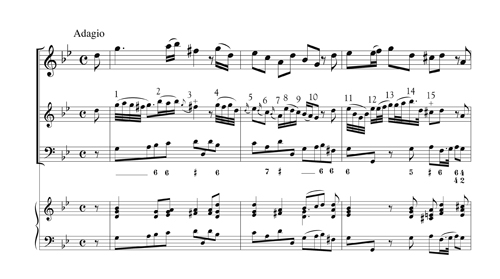
1. Turn 2. Escape Tone 3. Appoggiatura & Trill 4. Turn 5. Appoggiatura 6. Appoggiatura 7. Appoggiatura 8. Escape Tone 9. Passing Tone (Chordal 7th) 10. Passing Tone 11. Arpeggio 12. Repetition, Diminution 13. Repetition, Passing Tone 14. Chordal Leap 15. Trill
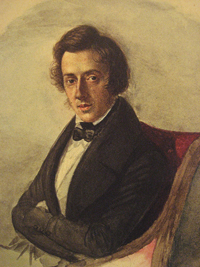 Frederic Chopin
Frederic Chopin
Prior to the nineteenth century, rubato remained a performance practice technique that was primarily spoken about but not yet notated in scores. The actual word rubato first began to appear in the keyboard scores of Frederic Chopin. It is printed in fourteen of his compositions that were written from 1820-1836. Chopin utilized earlier rubato throughout his musical career. In his pedagogy he taught his students the principles of earlier rubato by comparing the left hand to the conductor. Chopin used rubato to emphasize a climactic moment in a piece, bring out a non-harmonic tone, invigorate a repeated theme, or emphasize a particular mood.
Since his rubato only applied to a specific expressive moment, Chopin never wrote the direction tempo rubato in a composition. A special type of rhythmic rubato that is unique to the compositions of Chopin is found in his mazurkas. A mazurka is a triple meter dance form that originated in Poland, which was Chopin’s homeland. It is characterized with rhythmic syncopation and a prolonged accent on the second or third beat of the measure, which coincided with a tap of the heel in the dance. The rhythmic robbery that occurs is the result of hemiola and accent displacement. An infamous example of this type of rubato is seen in the opening measures of Chopin’s Mazurka in C Major, Op. 33 No. 3. As shown below, an emphasis is given to the second beat, with accent marks in the accompaniment underneath a lengthened dotted duration in the melody.
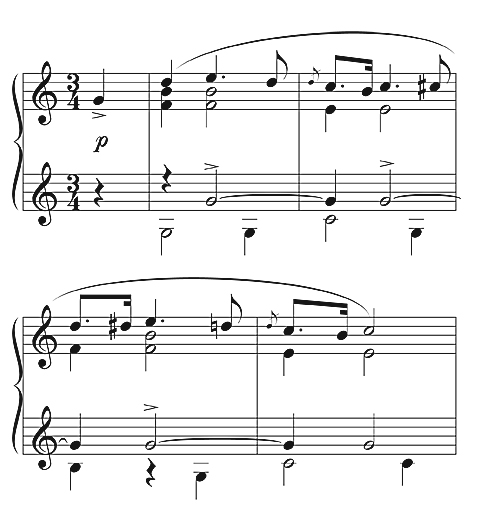
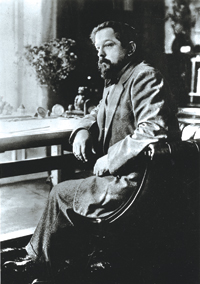 Claude Debussy
Claude Debussy
Regarded as the first major twentieth century composer, Claude Debussy is celebrated for his imaginative use of tone color, sonority, and imagery. Although associated with Impressionist French composers such as Ravel and Delius, Debussy’s music was inspired by the symbolist movement, which promoted spirituality and imagination. This influence is seen through Debussy’s use of musical imagery and fragmentation of motives. These motives are created through the juxtaposition of musical images, innovative harmony, and non-Western scales, such as whole-tone, octatonic, and pentatonic.
Debussy’s music consists of a relatively free and organic rhythmic flow. In a set of conversations with his old teacher Ernest Guiraud, Debussy outlined his conception of rhythm: “Rhythms are stifling. Rhythms cannot be contained within bars.” The idea of strict rhythm with a controlled pulse was not in Debussy’s musical vocabulary. However, despite the relaxed rhythmic atmosphere, each individual motive is rhythmically distinct because of the lack of traditional harmony and structure. Within the rhythm of a motive, Debussy often included the word rubato.
By the second half of the nineteenth century and onward, the term rubato primarily referred to the later type. Debussy, as a composer of the early twentieth century, incorporated elements of later rubato into his compositions. He believed in a creative freedom in music in order to engage the imagination of a listener. Debussy described his artistic aims in a note from 1902: “I wanted music to have a freedom that was perhaps more inherent than in any other art…to the mysterious affinity between nature and the Imagination.” Rubato is an expressive device that produces the effect of freedom through rhythmic flexibility. Therefore, it comes as no surprise that Debussy wrote the word rubato more often than any composer who came before him.
Debussy’s Syrinx for solo flute is a prime example of Debussy’s use of rubato within his unique compositional style. Written in 1913, Syrinx was the first modern composition written for unaccompanied flute. It was originally written as incidental music for Gabriel Mourey’s play, Psyche, and was meant to accompany the scene just before Pan died. Since Syrinx was to be played offstage as accompaniment to Mourey’s play, flutists of today traditionally perform this piece from far away, or with the stage lights down.
Syrinx is an evocative dramatization of the Greek myth of Pan and Syrinx from Ovid’s Metamorphoses. In fact, a “syrinx” is a set of panpipes, which is the instrument associated with Pan. The flute emulates the effect of the syrinx in the opening motive, which is found in varying capacities throughout the piece. Since the syrinx would have been played in an improvisatory fashion without written music, a performer may choose to play this piece with a semblance of artistic freedom, in order to bring the atmosphere and mood of this piece to life.
To alter the course of rhythmic flow in his compositions, Debussy often included directions such as cédez, serrez, and retenu. This remains true in Syrinx, where the terms retenu, très retenu, cédez, and en retenant jusq’ à la fin appear at the close of each of the three sections of the piece to indicate a slowing down of the tempo. In addition to adding an expressive effect, these tempo modifications function to evoke the image of a dying Pan. Debussy’s written rubatos often succeed shorter motives marked cédez or serrez. Expressions such as a tempo or au mouvt cancel out the tempo fluctuation. As shown below, this occurs at length in Syrinx.

Given the yielding of the tempo indicated by the marking of cédez combined with a decrescendo and descending line, the piece feels as if it is ending and that the release of energy symbolizes the ultimate death of Pan. Instead, with the addition of the marking rubato, Debussy turns the descending line around into an ascent. The music that follows is a flourish of motives that recall the original syrinx theme. Rubato adds to the expression of the mood of the piece and enhances the projection of the image of the syrinx. The effect of rubato is cancelled out with the tempo marking of au mouvt, and the return of the original syrinx motive.
Debussy’s harmonic and motivic exploration paved the way for new possibilities in the composition of music for future generations of composers. Debussy’s use of later rubato in the projection of musical images gives performers the freedom to use flexibility in tempo to communicate with an audience.
Igor Stravinsky vs. Schoenberg
In the Modern period composers increasingly felt pressure to compete with the timeless composers of the past. To create a distinct musical voice and a permanent place in the repertoire, composers used innovative techniques that would appeal to both performers and audiences. Stravinsky and Schoenberg were composers who chose two different pathways and consequently disagreed with each other.
Stravinsky’s works were influenced by Russian folk melodies, Neo-classicism, and Serialism. He took pride in his distinct rhythms and mechanical strictness of time. In 1963 he listed the differences between Schoenberg and himself by declaring that Schoenberg made “much use of rubato,” while his own music contained “no rubato . . . mechanical regularity.”
However, despite Stravinsky’s attempts to separate himself from the technique, he did write many rubatos in his compositions. In fact, the word rubato is written thirty times in sixteen of his works from the period 1902-1963. In contrast Schoenberg remained committed to the German classical tradition. In an effort to match the formal structure of tonal music, Schoenberg devised his twelve-tone method, which called upon a row of the twelve chromatic pitches that were able to recall the musical structures and gestures of the past. Schoenberg even included the word rubato in two of his twelve-tone works; found in his Piano Concerto of 1942 and his Fourth String Quartet of 1936.
Although Stravinsky and Schoenberg represented two opposing paths in the Modern period, one thing they had in common was the use of rubato as an expressive technique, despite Stravinsky’s attempts to disassociate his own style with the technique. Perhaps he feared that performers would exaggerate the effect of rubato to the demise of his original vision. By writing it in appropriate places himself, he perhaps hoped to prevent this potential disaster. Schoenberg, on the other hand, was not offended by the use of rubato. He even marked it in his twelve-tone compositions, which are notorious for their rhythmic complexity and disassociation with the lyrical melodies of tonal music.
Elliott Carter
As one of the most renowned American composers of the Contemporary period, Elliott Carter has earned a permanent place in the repertoire as a result of his innovations in rhythm. Carter composes in a complex, non-serial compositional style that is characterized by his developments in rhythm and form. The main rhythmic developments of Carter’s compositional style are metric modulation and superimposed contrasting rhythmic characters. The creation of metric modulation began with Carter’s 1948 Cello Sonata. Metric modulation, similar to tonal modulation, involves a change of tempo from one meter to another through a pivot stage, where a unit of the first meter is equal in duration to a unit of the second. This results in a directly proportional change of duration.
Carter frequently superimposes contrasting rhythms in his compositions. The source of this technique is jazz music, where a strict pulse of the rhythm section contrasts with the freedom of a soloist. The two rhythmic characters that are juxtaposed are metric pulses and rubato. The metric pulses are indicated by terms such as sempre guisto or meccanico, and are played as downbeats. Within the rubato character, on the other hand, a performer is welcome to take expressive liberties with the pulse. It is specified with the markings espressivo or quasi rubato. These two contrasting characters are often found in alteration, where passages with a metric pulse alternate with rubato passages.
Rubato as an expressive technique has had a strong presence and evolved over the course of music history. Developments in notation during the tenth century due to the codification of Gregorian chant led to the advent of tempo markings and modifications in the Baroque period. This in turn led to the expressive use of rubato in the Romantic and Modern periods. The use of rubato has inspired many rhythmic innovations in the Contemporary period, such as Elliott Carter’s use of metric modulation. By incorporating rubato into a performance, musicians have the power to invigorate a composer’s vision by adding a unique element of expressivity. From the free rhythmic flow of Gregorian chant to the superimposed contrasts of Carter, rubato has proven to be an omnipresent expressive device throughout time.
Bibliography
Bedenbaugh, Kay. Rubato in the Chopin Mazurkas. DMA diss., Stanford University, 1986.
Burkholder, J. Peter, Donald J. Grout, and Claude V. Palisca, eds., A History of Western Music, 7th ed. New York: W.W. Norton & Company, 2006.
Chopin, Frederic. Mazurkas. Edited by Desire Níkaoua. Paris: Editions Henry Lemoine, 1995.
Debussy, Claude. Syrinx. Paris: Jobert, 1927.
Hudson, Richard. Stolen Time. Oxford: Oxford University Press, 1994.
Lenz, Wilhelm. The Great Piano Virtuosos of Our Time. New York: G. Schirmer, 1899.
Parrish, Carl. The Notation of Medieval Music. New York: W. W. Norton & Company, 1957.
Quantz, Johann Joachim. On Playing the Flute. Edited by Edward R. Reilly. Boston: Northeastern University Press, 2001.
Schiff, David. The Music of Elliott Carter. London: Eulenburg Books, 1983.
Taruskin, Richard and Piero Weiss, eds. Music in the Western World. Belmont: Schirmer Cengage Learning, 2008.
Telemann, Georg Philipp. Methodical Sonatas for Violin or Flute and Basso continuo, Edited by Max Seiffert. Kassel: Berenreiter, 1955.
